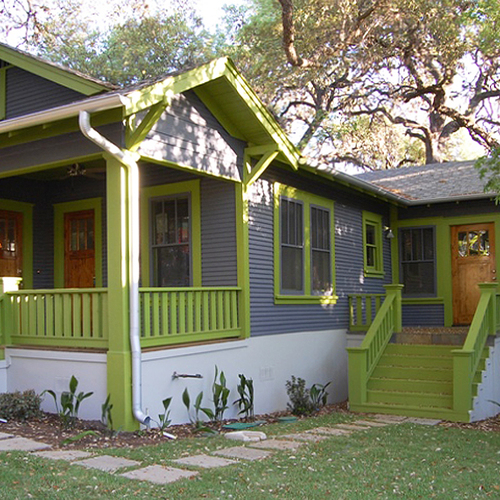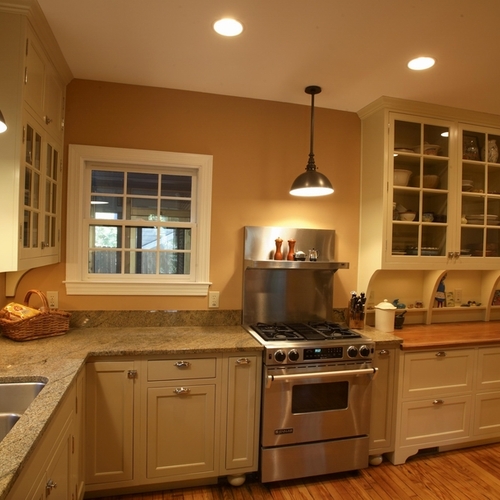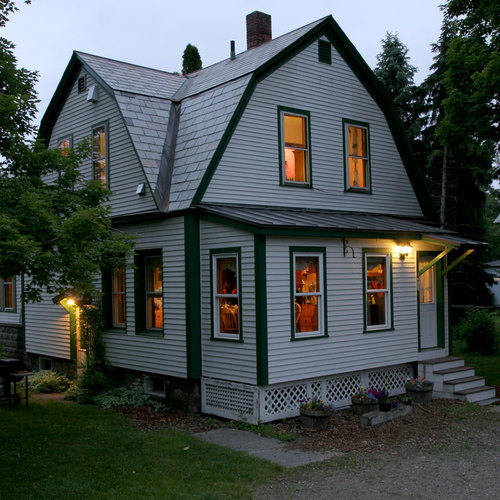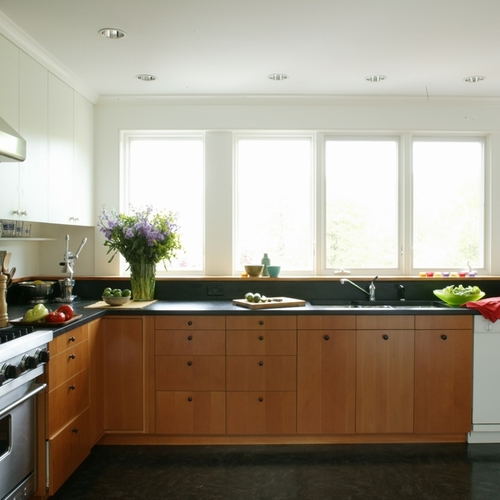
Image Credit: David Bolt
Image Credit: David Bolt VENTING AND INSULATION REDUCE THE COOLING LOAD. Thin plywood was fastened to the underside of the rafters and 2-part urethane foam insulation was sprayed below that. The continuous plane of foam provides a better thermal break than if the insulation was between the rafters. In warmer months, the empty rafter bays now act as a vented buffer between the hot roof and the semi-conditioned attic.
Image Credit: David Bolt A HOME'S SITE IS IMPORTANT TO CONSIDER - maybe more so in a existing home where you don't have the luxury of choosing the orientation of the building. David and his family have made several choices that help protect their surroundings and take advantage of them. Water conserving appliances, like their front loading washing machine, put less pressure on their septic system, reducing the chances of contaminating the nearby lake. In the summertime, breezes coming off the lake help cool the house and dry laundry on the clothesline.
Image Credit: David Bolt USING THE GRID TO "STORE" ELECTRICITY. The red box on the right is the inverter that converts the direct current (DC) from the PV panels to the alternating current (AC) required by the circuits in the house. This particular system is grid tied. Electricity travels either way through the utility company's lines depending on whether the house is producing excess power or demanding more. With David's meager annual electric needs, he more than breaks even.
Image Credit: David Bolt KEEPING UP WITH THE FAMILY'S NEEDS. The 2005 numbers represent seasonal use of the home before the energy upgrades. Even though the 2007-2008 electric consumption is higher than in 2006-2007, the numbers are still quite small for a family of four.
Image Credit: David Bolt IT'S NOT THE MOST GLAMOROUS FEATURE, but the waterless urinal does double duty to conserve resources. Of course it saves water, but that in turn offsets electricity needed to pump water up from the home's well.
Image Credit: David Bolt
You might not know this is a net-zero home by looking at it — that’s the point
Creating at least as much energy as it consumes, this 1970s ranch on a lake shore in Tennessee resembles most other Middle American homes, which is a good thing. It is proof that you can work with what you have, don’t have to be fancy or complicated, and can accomplish a lot. Owner and renovator David Bolt says of his net-zero home, “We haven’t paid a utility bill since April 2006.”
A process and a story
David is both the owner of this house and the founder of a forward-thinking energy consulting company, appropriately called Sustainable Future. When he started this project, he could have used his now better-educated self for the advice, products, and services he dispenses today. Even with his negative utility bill, he still considers his home to be a work in progress.
A quick itemization of upgrades he’s done over the last five years includes a robust installation of PV panels and solar hot water collectors that provide all of the home’s electrical power and hot water and meet most of it’s HVAC needs; structural changes that made the building tighter and better insulated; and various small remodeling projects that made the house more gracious to live in, like installing bamboo flooring and ceramic tile to replace carpet and vinyl composition tile (VCT).
However, just as big an ‘upgrade’ was adjusting to his own goal of living (and having his family live) within a daily energy budget of 10 kW hours (according to the Energy Information Administration, the average U.S. household uses more than 70 kW hours).
The first thing he did was install a whole house meter to track down where his electricity was going. He discovered significant draws from so-called phantom loads—the energy that still gets expended even when you think everything is turned off, or that dribbles away because some appliance needs a tune-up or replacing.
Lifestyle changes play a role
David’s family found that many small, easy changes added up—so they made them. They plugged electrical devices like TVs, the microwave oven, computers and stereos into power strips, and turn the strips off when the devices are not in use. Freshly made coffee goes right into a thermos, which eliminates the tiny amount of electricity needed to keep it warm in the coffee maker. When they can, they hang laundry to dry in the fresh breeze. They got a new refrigerator—the old one gobbled energy. It all adds up over time.
Their motivation led them to a heightened awareness — “Is it really necessary to have an electric doorbell?” David wonders, assessing their total carbon footprint. They might switch to “an old school doorbell” — a door knocker. This curiosity and thoughtfulness is catching. Even their 12-year-old daughter, suspicious of the number of drinking straws she might add to landfills over her lifetime, has sworn them off.
Many parts add up to the whole
David’s attic is only two to three degrees warmer than the rest of the house, even on a sweltering summer day (a typical home might see a 30-60 degree difference). This means the family can largely do without air conditioning. Some of the sun’s energy is absorbed by the solar panels on the roof. The highly reflective metal roof bounces off more. On the inside, David has followed well-established best venting practices providing ample flow of air between eave and ridge vents, something usually paid lip service, if followed at all. He has also improved on it by isolating the attic space from the rafter bays with a skin of plywood and then a 4” layer of open-cell soy-based foam.
Double pane windows, spot air sealing, a whole-house fan, an 18 SEER heat pump, and the well-integrated, high-performance solar hot water system round out improvements. David still tracks his energy usage regularly, and tinkers, and plans. His next house, he says, will have hydronic radiators.
Weekly Newsletter
Get building science and energy efficiency advice, plus special offers, in your inbox.
Lessons Learned
An engineer, David is the first to say “this home is a big experiment.” He acknowledges it can be hard to choose the best green path, even for an expert, but he concludes that “at some point you just have to throw the dice and go with it.” He advises people to act on what motivates them, whether its efficiency, aesthetics, financial constraints, or behavioral changes.
He chose the route of efficiency and deep personal involvement, and did much of the work himself. Constantly improving on his efforts, he suggests you don’t have to do it all at once. His solar water system was improved five times as he surmounted inadequate information, rapidly advancing technologies, and discovering how to orient his solar panels for optimal summer and winter bias. Until he made this last change in 2007, for instance, they’d run out of hot water in October and had to warm it with electricity from the grid.
It’s still hard to make a financial case for some green upgrades like PV. But, he says, state and federal incentives and financing help, such as those he got from the Tennessee Valley Authority, which has one of the most generous programs in the nation. To check what’s available in your state, go to: www.dsireusa.org, a comprehensive database of local, state, federal, and utility company incentive programs.
Every little bit helps.
General Specs and Team
| Location: | Harriman, TN |
|---|---|
| Bedrooms: | 3 |
| Bathrooms: | 3 |
| Living Space: | 2400 |
| Cost: | 240 |
| Additional Notes: | This project was started in late 2005 and was a patchwork of remodeling projects that finished in July 2007. The cost has been spread out over this time. |
Builder: David Bolt, founder/owner Sustainable Future, LLC
Architect/Designer (2005 remodel): Elizabeth Eason Remodeling Proposals
Construction
Foundation: uninsulated concrete slab on grade
Walls:
- Below grade: concrete block/unknown waterproofing
- Above grade: concrete block faced with exterior insulating and finish systems (EIFS)
- Interior: 2x4; kraft-faced fiberglass batt insulation
- Exterior (above stucco): vinyl siding over XPS foam board on old siding and fiberboard; 2x4 wood framing with kraft-faced fiberglass batts (all above-grade walls approx. R-20)
Windows: double-pane wood casement; SHGC .30, U-factor .31 (R-3.2, Anderson)
Roof: standing seam metal Galvalum; 2x6 rafters vented at eaves and ridge; 1/4-in. plywood on interior side of rafters sprayed with 4-in. open-cell soy/urethane foam (R-20)
Garage: detached
Energy
- Whole-house electric usage meter
- Windows added for natural daylighting
- CFL throughout
- Energy Star appliances
- All devices equipped with "standby" modes are on power strips with switches to eliminate phantom loads
- Operable windows for natural cross ventilation
- Vented roof reduces cooling load
- Whole-house fan
- Tile floors (increase thermal mass of house)
Energy Specs
Heating/cooling: 2-ton heat pump (SEER 18), wood stove
Water heating: 4 flat plate collectors, 120-gallon insulated storage tank; electric back up
Annual energy use:
- Wood: approx. 9.6 MMBtu
- Photovoltaic: 4000 kWh (not including excess electricity returned to grid)
- Solar hot water: 18,800 kBtu estimated production and use
HERS index: 66
Water Efficiency
- Waterless urinal (Falcon)
- Low-flow showerheads
- Low-water-usage washing machine
Indoor Air Quality
Green Materials and Resource Efficiency
- All construction waste recycled or repurposed
- Bamboo flooring
- Custom humidity retention system in bathroom conserves hot water
- Metal roof (durable, recyclable)
Alternate Energy Utilization
Photovoltaic: 3kW solar PV connected to grid (cost, $25,000)
Solar water heater: 112 sq. ft. of flat plate collectors and insulated tank (cost $12,000)
wood stove: EPA-approved; 30,000 Btu per hour










2 Comments
Flat panels v evacuated tubes
What are the relative merits of evacuated tubes versus flat panels for hydronic radiators?
Info on solar water heating
https://www.greenbuildingadvisor.com/green-basics/solar-heat
Log in or create an account to post a comment.
Sign up Log in